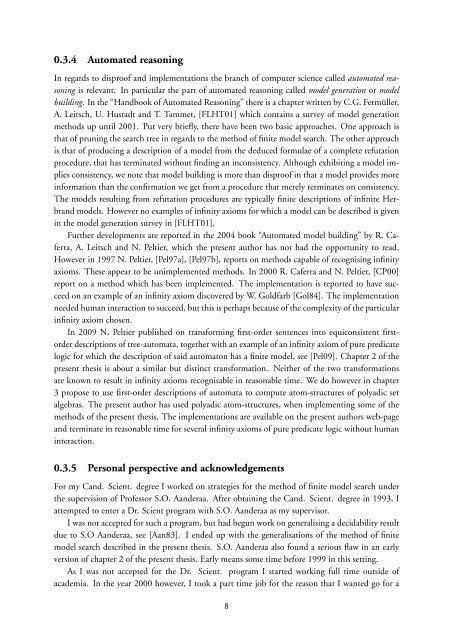On the methods of mechanical non-theorems (latest version)
On the methods of mechanical non-theorems (latest version)
On the methods of mechanical non-theorems (latest version)
You also want an ePaper? Increase the reach of your titles
YUMPU automatically turns print PDFs into web optimized ePapers that Google loves.
0.3.4 Automated reasoning<br />
In regards to dispro<strong>of</strong> and implementations <strong>the</strong> branch <strong>of</strong> computer science called automated reasoning<br />
is relevant. In particular <strong>the</strong> part <strong>of</strong> automated reasoning called model generation or model<br />
building. In <strong>the</strong> “Handbook <strong>of</strong> Automated Reasoning” <strong>the</strong>re is a chapter written by C.G. Fermüller,<br />
A. Leitsch, U. Hustadt and T. Tammet, [FLHT01] which contains a survey <strong>of</strong> model generation<br />
<strong>methods</strong> up until 2001. Put very briefly, <strong>the</strong>re have been two basic approaches. <strong>On</strong>e approach is<br />
that <strong>of</strong> pruning <strong>the</strong> search tree in regards to <strong>the</strong> method <strong>of</strong> finite model search. The o<strong>the</strong>r approach<br />
is that <strong>of</strong> producing a description <strong>of</strong> a model from <strong>the</strong> deduced formulae <strong>of</strong> a complete refutation<br />
procedure, that has terminated without finding an inconsistency. Although exhibiting a model implies<br />
consistency, we note that model building is more than dispro<strong>of</strong> in that a model provides more<br />
information than <strong>the</strong> confirmation we get from a procedure that merely terminates on consistency.<br />
The models resulting from refutation procedures are typically finite descriptions <strong>of</strong> infinite Herbrand<br />
models. However no examples <strong>of</strong> infinity axioms for which a model can be described is given<br />
in <strong>the</strong> model generation survey in [FLHT01].<br />
Fur<strong>the</strong>r developments are reported in <strong>the</strong> 2004 book “Automated model building” by R. Caferra,<br />
A. Leitsch and N. Peltier, which <strong>the</strong> present author has not had <strong>the</strong> opportunity to read.<br />
However in 1997 N. Peltier, [Pel97a], [Pel97b], reports on <strong>methods</strong> capable <strong>of</strong> recognising infinity<br />
axioms. These appear to be unimplemented <strong>methods</strong>. In 2000 R. Caferra and N. Peltier, [CP00]<br />
report on a method which has been implemented. The implementation is reported to have succeed<br />
on an example <strong>of</strong> an infinity axiom discovered by W. Goldfarb [Gol84]. The implementation<br />
needed human interaction to succeed, but this is perhaps because <strong>of</strong> <strong>the</strong> complexity <strong>of</strong> <strong>the</strong> particular<br />
infinity axiom chosen.<br />
In 2009 N. Peltier published on transforming first-order sentences into equiconsistent firstorder<br />
descriptions <strong>of</strong> tree-automata, toge<strong>the</strong>r with an example <strong>of</strong> an infinity axiom <strong>of</strong> pure predicate<br />
logic for which <strong>the</strong> description <strong>of</strong> said automaton has a finite model, see [Pel09]. Chapter 2 <strong>of</strong> <strong>the</strong><br />
present <strong>the</strong>sis is about a similar but distinct transformation. Nei<strong>the</strong>r <strong>of</strong> <strong>the</strong> two transformations<br />
are known to result in infinity axioms recognisable in reasonable time. We do however in chapter<br />
3 propose to use first-order descriptions <strong>of</strong> automata to compute atom-structures <strong>of</strong> polyadic set<br />
algebras. The present author has used polyadic atom-structures, when implementing some <strong>of</strong> <strong>the</strong><br />
<strong>methods</strong> <strong>of</strong> <strong>the</strong> present <strong>the</strong>sis. The implementations are available on <strong>the</strong> present authors web-page<br />
and terminate in reasonable time for several infinity axioms <strong>of</strong> pure predicate logic without human<br />
interaction.<br />
0.3.5 Personal perspective and acknowledgements<br />
For my Cand. Scient. degree I worked on strategies for <strong>the</strong> method <strong>of</strong> finite model search under<br />
<strong>the</strong> supervision <strong>of</strong> Pr<strong>of</strong>essor S.O. Aanderaa. After obtaining <strong>the</strong> Cand. Scient. degree in 1993, I<br />
attempted to enter a Dr. Scient program with S.O. Aanderaa as my supervisor.<br />
I was not accepted for such a program, but had begun work on generalising a decidability result<br />
due to S.O Aanderaa, see [Aan83]. I ended up with <strong>the</strong> generalisations <strong>of</strong> <strong>the</strong> method <strong>of</strong> finite<br />
model search described in <strong>the</strong> present <strong>the</strong>sis. S.O. Aanderaa also found a serious flaw in an early<br />
<strong>version</strong> <strong>of</strong> chapter 2 <strong>of</strong> <strong>the</strong> present <strong>the</strong>sis. Early means some time before 1999 in this setting.<br />
As I was not accepted for <strong>the</strong> Dr. Scient. program I started working full time outside <strong>of</strong><br />
academia. In <strong>the</strong> year 2000 however, I took a part time job for <strong>the</strong> reason that I wanted go for a<br />
8
















